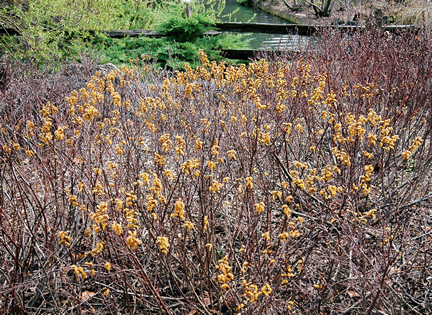
Woody > Aronia > Aronia arbutifolia > Aronia arbutifolia 'Brilliantissima'
Aronia arbutifolia
'Brilliantissima'
Brilliant Red Chokeberry
Origin: Horticultural origin.
Mike's
Opinion


"
A year-round eye-catcher with its dark green leaves in the spring and summer, that are accented with showy pinnacles of small white-pink flowers. Great for attracting pollinators such as bees and butterflies. Brilliant bright red autumn foliage is its most favourable attribute, including its small bright red berries that persist throughout the winter months. It is a great shrub to plant anywhere like your backyard or alongside a highway, due to its salt and pollution tolerance.
Michael Pascoe, NDP., ODH., CLT., MSc. (Plant Conservation)
"
| Family |
| Rosaceae |
| Genus |
| Aronia |
| Species |
| arbutifolia |
| Cultivar |
| 'Brilliantissima' |
| Category |
| Woody |
| Type |
| Shrub (deciduous) |
| Pronunciation |
| USDA Hardiness Zone |
| 4-9 |
| Canadian Hardiness Zone |
| 2 - 5a |
| RHS Hardiness Zone |
| H7 |
| Temperature (°C) |
| -35 - (-29) |
| Temperature (°F) |
| -30 - (-20) |
| Height |
| 2-3 m |
| Spread |
| 1-2 m |
Photographs
Description and Growing Information
Flowering Period
| General Description |
| A beautiful native, multi-season, deciduous shrub that is an excellent choice for mass plantings or groupings. It is abundant with spring-blooming flowers and fruit that ripens in late autumn. The dark-green leaves change to a brilliant bright red in autumn, commonly being compared to Euonymus alatus (burning bush). |
| Landscape |
| Common uses for the shrub include mass plantings and groupings, roadside plantings for its salt tolerance, hedges, beds, borders, naturalizing areas and to complete woodland gardens. |
| Cultivation |
| Aronia arbutifolia grows in a moist but well-drained soil in full sun. While this is what it prefers, it can also tolerate dry to some water-logged soil. It does not have a specific pH preference. It is also salt tolerant and slightly pollution tolerant. Grows best in USDA hardiness zones 4 - 9, Canadian hardiness zones 2 - 5a, RHS H7. Its habitat may range from marshlands and wetlands, to grassy plains and rocky slopes. |
| Shape |
| A vertical, somewhat rounded bush in an oval or vase shape. |
| Growth |
| Slow |
| ID Characteristic |
| Aronia arbutifolia has glossy dark-green oval-shaped leaves that change to a brilliant red in autumn. It also has small white/pink flowers in spring and bright red small berries that persist throughout the winter season. |
| Pests |
| Leaf spots are a common cause of premature leaf drop, but not a serious threat to the plant. Possible pests include apple maggot, cherry fruit worm, grasshoppers, Japanese beetle, spotted winged drosophila and tarnished plant bug because of the relation with the apple family. |
| Habitat |
| Horticultural origin. |
| Bark/Stem Description |
| Smooth, red-brown bark, with noticeable whitish lenticles. |
| Leaf Description |
| Leaves are to 8 cm long, dark-green, and glossy, with an entire margin. They have an oval, oblong, obovate, or elliptical shape. The leaf's underside has more of a green-grey hue. Leaves change to a brilliant bright red in autumn before abscission. |
| Flower Description |
| Flowers have a white/pink hue and notably long-lasting, showing in dense groups of 9-20. The flower itself has bright red anthers. These flowers last a little longer than a week once they have bloomed. |
| Fruit Description |
| Fruit is up to 6.5 mm in diameter with a bright red colour, ripening late and persisting into winter. Small and glossy berries grow in clusters, but are still considered to be simple fruits. |
| Colour Description |
| The bark is a red-brown colour with noticeable white lenticels. The flowers bloom in a white/pink colour with bright red anthers. The leaves change from a glossy dark-green colour to a brilliant bright red in autumn. It also produces berries that withstand the winter and continue to give it appeal all year round with its bright red berries. |
| Texture Description |
| Leaves have a smooth texture and entire margins. The underside of the leaves have very small hairs that are barely noticable, but add some texture. The bark is also smooth. |
| Propagation |
| Propagate through semi-ripe cuttings, layering, or removal of suckers. It is also possibly to propagate through seed by removing the fleshy coating and stratifying for 12 - 14 weeks at a temperature below 5°C, or by sowing in autumn in an open seed bed. It is most easily propagated through the division of the plant's root suckers. |
| Ethnobotanical Uses (Disclaimer) |
| Used as a super-food in Europe due to the berry's antioxidant power. Also, the berry is used to make a juice. |



